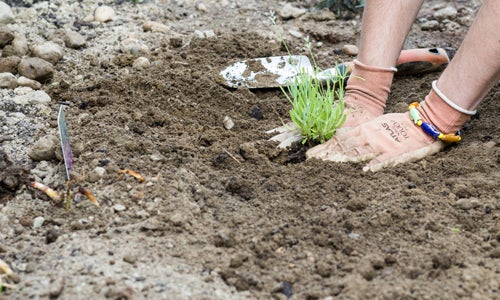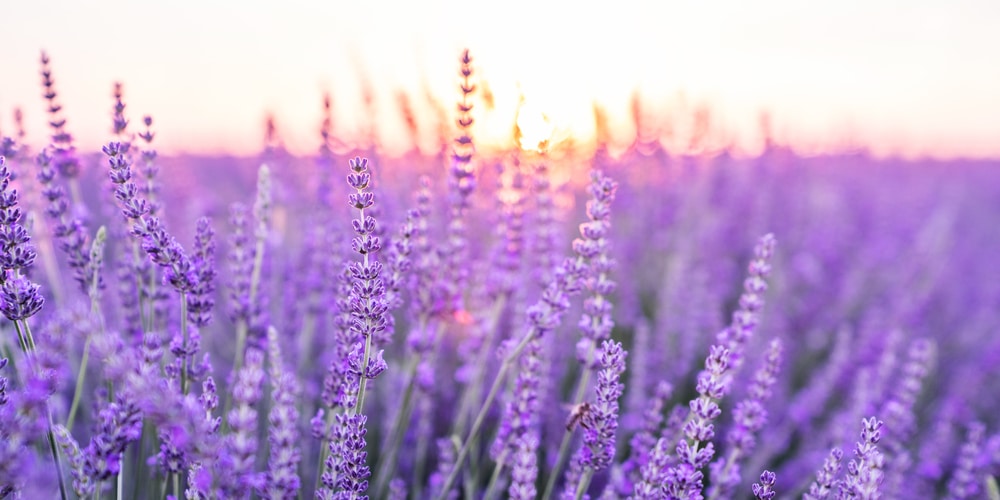
Although lavender may thrive in soils as gently acidic as pH 6.5, they usually prefer alkaline soils up to pH 8. This mimics the natural Mediterranean soil conditions where lavender grows in sandy, alkaline, well-draining soils.
If you don’t know how to measure your soil’s pH (there is a cheap way to do so) or what growing options you have for lavender if your soil is acidic, keep reading.
Table of Contents
Lavender in Acidic Soil
Lavenders thrive in sandy or gravelly soils with an alkaline pH of around 7.5 since they are accustomed to growing in calcareous soils in the Mediterranean region of southern Europe.
However, lavenders can survive in somewhat acidic soils (pH 6.5), especially the English lavender type, which is more resilient and still produces oil and blooms.
However, in acidic soils with a pH lower than 6.5, lavenders will either grow extremely slowly or not at all (the lower the pH the more acidic).
The lavenders cannot absorb nutrients and will perish if the soil is more acidic than pH 6.5, unlike several other regularly grown garden plants that thrive in more acidic soil.
Lavender may still thrive and grow without issues on soil that is between pH 6.5 and 7 (slightly acidic to neutral). When the pH of the soil falls below 6.5, lavender only truly begins to exhibit signs of stress (poor growth, fewer flowers).
The three most practical choices, however, if you do have acidic soil and wish to grow lavenders, are as follows:
- Lavender can be planted or moved into a pot. In contrast to a garden, where soil must be heavily adjusted, you have unlimited control over the soil mixture for lavender in a container. (To learn how to accomplish this without transplant shock, read my post How to Transfer Lavender.)
- Planting lavender in a raised bed provides the same benefit as doing so in a container in that you can add new soil that is better suited for lavender growth.
- To change your garden soil’s acidic pH to the alkaline range required by lavenders, use lime or wood ash (both of which are alkaline).
How to Determine Whether your Soil is Acidic, Neutral or Alkaline
Setting the soil pH before purchasing plants is a prudent precaution that will ultimately save you a lot of money.
With a soil gauge, which you can get on Amazon, you can determine the pH of your garden soil in the most cost-effective manner. It is not necessary to have any technical skills to operate this device. Simply insert the probes all the way into the ground, and the device will read the pH of your soil and, what’s even better, is reasonably priced!
To make sure that all of my new plants are planted in the proper soil pH, I use this gauge throughout my garden.
If your garden soil is chalky, this will be ideal for growing lavender because chalk soil drains quickly, replicating the conditions lavender prefers, and chalk soil is alkaline (typically around pH 7.5). If your soil is not chalky, it is difficult to determine the pH without using a gauge to accurately test.
How to Amend Acidic Soil for Growing Lavender

Growing lavender in a container is the simplest approach; the pot should be at least 16 inches across to accommodate adequate soil for lavender plants. You should also add 1 tablespoon of agricultural lime to your soil mixture and stir it into the soil (which has the effect of increasing soil pH to be more alkaline)
All that is required to establish the proper pH range for growing lavenders in a pot with soil that measures 16 inches across and the same proportionate height is. (For further details, see my post on picking the ideal pot for lavenders.)
After adding the lime to the soil, there will be no need to continue modifying it, and the lavender should thrive in its new environment. (Read my post to find out the best soil combination for lavender plants in pots.)
Since you are working with a considerably larger volume of soil when using raised beds and growing lavender in the garden soil, it is crucial to adhere to the manufacturer’s detailed instructions.
You must make a long-term alteration to the soil’s pH so that it is ideal for lavenders if you intend to plant multiple lavenders in an area of acidic soil in an open garden.
Three months before to planting, prepare the soil (by adding lime and sand or gravel for better drainage) and test the pH of the soil on a regular basis to make sure the soil is at least pH 6.5, if not closer to pH 7.5.
For each plant, you should amend the soil to a depth of 18 inches so that the roots of the lavender plant can grow to their full maturity.
Use a soil gauge to measure the pH of the soil and apply extra lime if necessary. It is important to note that you should always follow the manufacturer’s directions to ensure the best outcome. Avoid adding too much lime at once since the soil may become too alkaline for lavender and you will then need to apply sulphur to balance the alkalinity in order to maintain the pH.
Key Takeaways:
- Only somewhat acidic soil (pH 6.5) will allow lavender to grow; however, alkaline soils up to pH 8 are preferred.
- English lavender cultivars are more resilient than French and Spanish cultivars and are better able to withstand mild soil acidity than other species.
- You can grow lavender in containers or raised beds as an alternative if your garden soil is acidic, or you can add lime to it.
- Use a soil gauge to measure the pH of your garden soil to find out whether it is acidic, neutral, or alkaline. These are simple to use and can eliminate any uncertainty, allowing you to invest in plants with confidence that they will flourish in the appropriate type of soil.
- The pH of the soil can be changed from acidic to alkaline by adding cultural lime to the soil, which makes the soil ideal for producing lavender.
